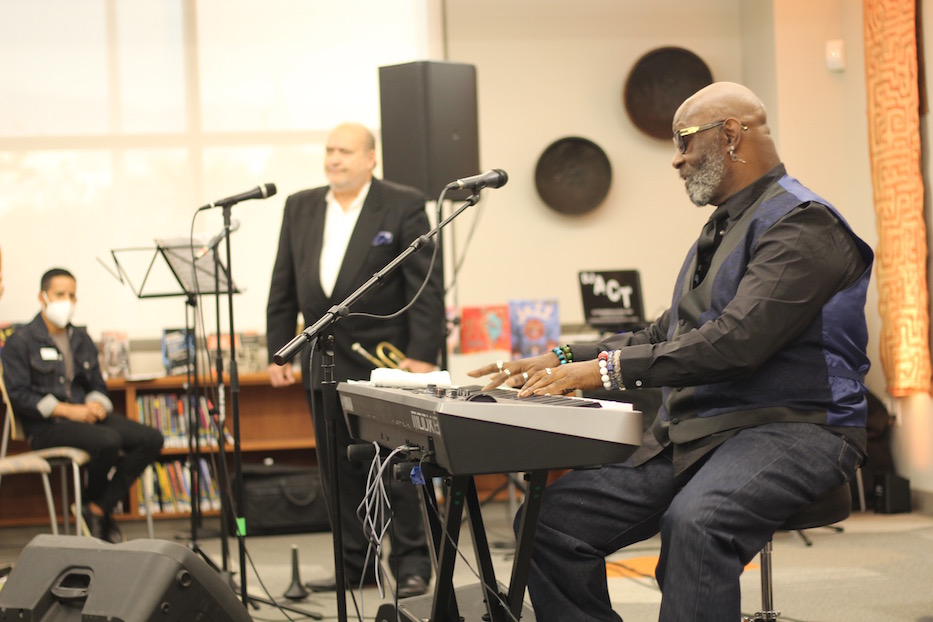
Dixwell | Jazz | Long Wharf Theatre | Music | Arts & Culture | New Haven Free Public Library | Arts, Culture & Community | Arts & Anti-racism
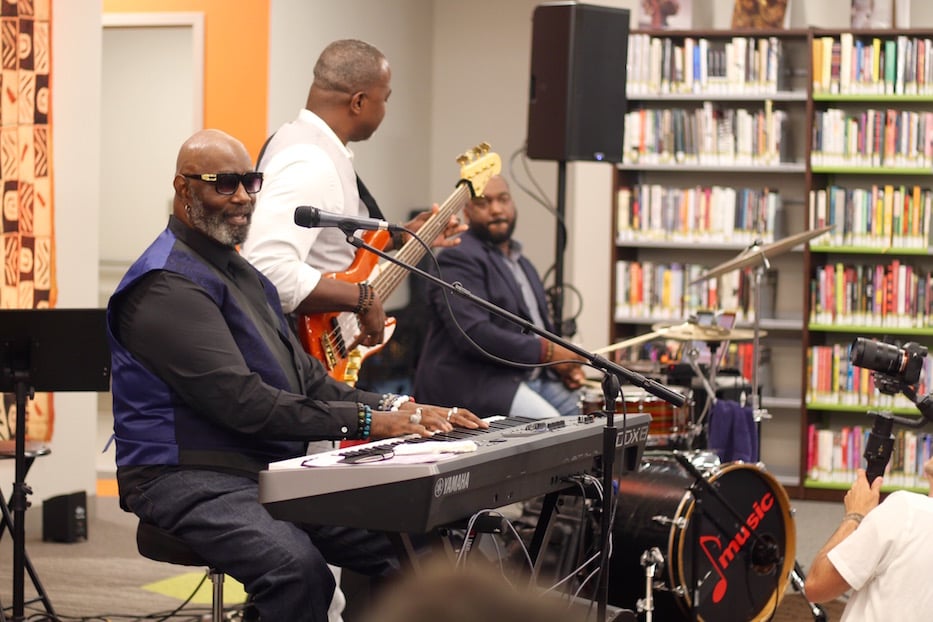
Chris "Big Dog" Davis with Ace Livingston and Dexter Pettaway, Sr. Lucy Gellman Photos.
Stetson Library was jamming to Scott Joplin. On the keys, Chris “Big Dog” Davis started with a hollow, sharp sound, then turned a dial that let keys echo into each other. The music rose to the ceiling and wove through the bookshelves, nestled against their snugly packed spines. Suspended somewhere over the audience, Joplin’s spirit took a spin around the space, and then found his home back at the keyboard.
The last notes of “The Entertainer” rang out, one after the other, until only an echo remained.
That performance kicked off Jelly Roll’s Jam Tuesday night, a two-hour celebration of Jelly Roll Morton from Davis, Dawn Tallman, Maysa, Dexter Pettaway, Sr., Ace Livingston, and Harold Zinno., Jr. A joint initiative of Long Wharf Theatre the New Haven Free Public Library, the concert doubled as a preview for Jelly’s Last Jam, a concert reading of which will take place Sept. 17 and 18 at Long Wharf’s 222 Sargent Dr. home.
It pays homage to Morton, who declared himself the father of jazz music, and ultimately paid for that claim with his career and his life. The performance is part of Long Wharf’s 2022-2023 season, “Everywhere for Everyone,” timed with its move to itinerancy later this year. Tickets and more information are available here.
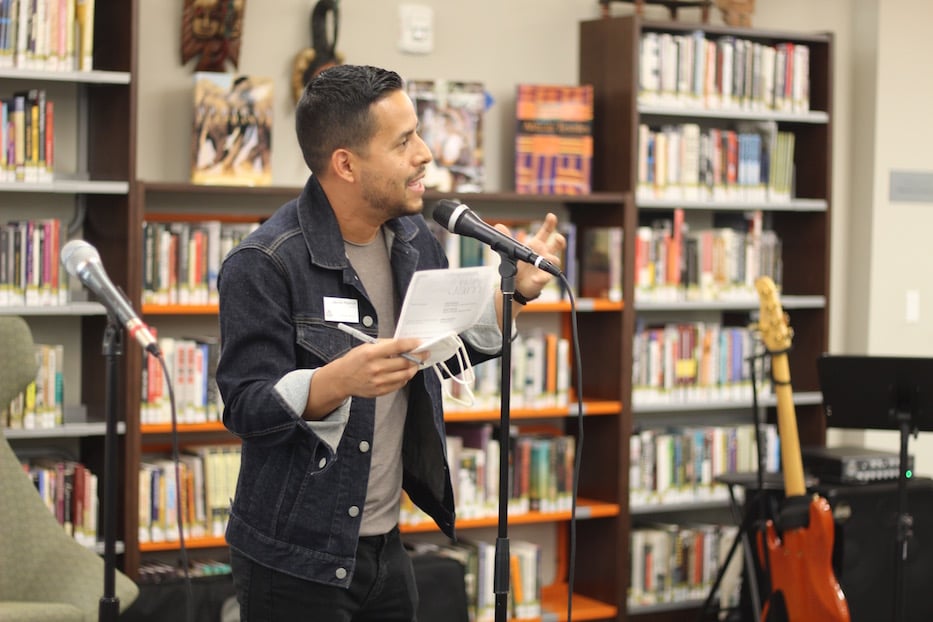
Long Wharf Theatre Artistic Director Jacob Padrón: "You know y’all when you’re in the presence of greatness?”
“The minute I sat down and was sitting across from Chris [Davis]—you know y’all when you’re in the presence of greatness?,” said Long Wharf Artistic Director Jacob Padrón, who worked closely with Stetson Branch Manager Diane Brown to plan the event. “You’re in the presence of someone so special, so spectacular, someone … I just felt so lucky that I was meeting this man, and that he said yes to working with Long Wharf Theatre and bringing us together.”
The concert has been over two years in the making. In March 2020, Padrón announced that Jelly’s Last Jam would cap off his inaugural season as artistic director. Just two days later, schools, businesses, and organizations closed as the first Covid-19 cases hit New Haven. By the next Monday, the theater had closed its physical doors and was working to reimagine its season.
Two years later, the theater has reopened its doors, returned to in-person programming, and announced a move to itinerancy that will begin later this year. As it begins that transition, Padrón said, he and staff at the theater wanted to hold onto the project in some form. He credited Brown for the vision for the event.
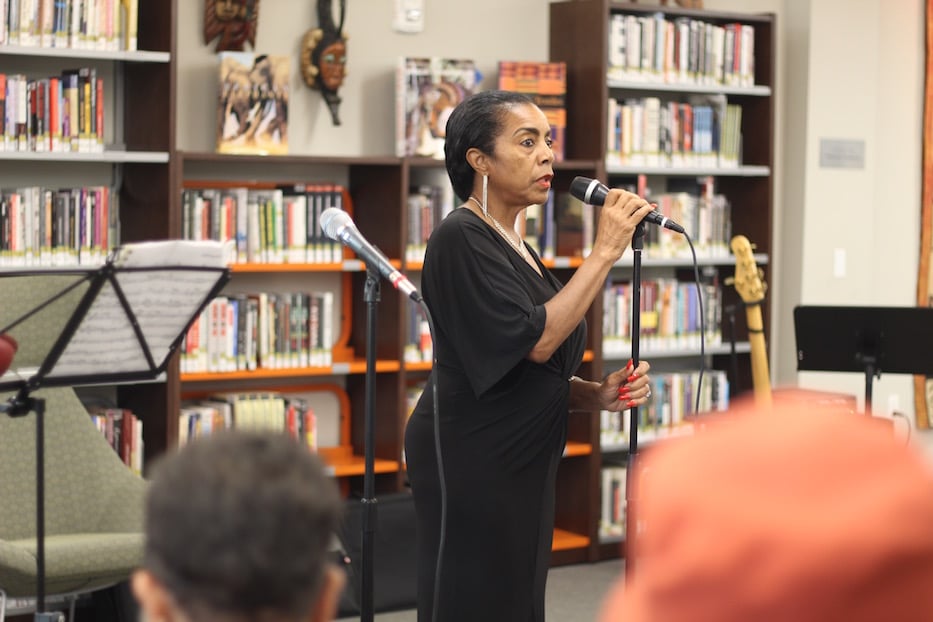
Stetson Branch Manager Diane X. Brown.
“We don’t want to give up on telling that story,” Padrón said. “And we don’t want to give up on bringing the community together to celebrate the music of Jelly Roll Morton. So this, tonight, is a bit of a sneak peek into that artistry and into that music.”
As over 100 listeners packed the library Tuesday, the performance became a model for what that move might look like. Just a little before 6 p.m., a line wound out the door of the Dixwell Community Q House and down Foote Street, nearly reaching into a nearby parking lot. As they made their way to the second floor of the library, attendees filled seats, then made an impromptu standing room section in the back and among the bookshelves.
Inside, musician Cliff Schloss took the mic to give people a crash course in who Morton was—and the extraordinary, sometimes braggadocious mark he left on both American and global music history. After “I did some digging,”Schloss found the story of Ferdinand Joseph LaMothe, a New Orlenian born on the lip of the twentieth century. Born into a Creole family, Morton started performing publicly when he was just 14, playing in New Orleans’ still highly segregated red light district.
“It was really the only place Black musicians could play,” Schloss said.
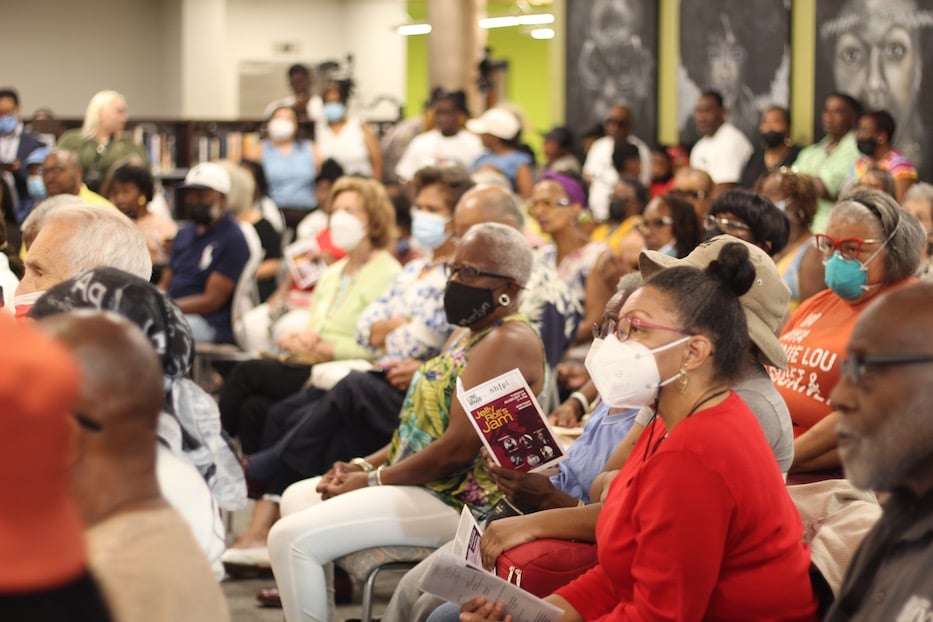
Worried it would tarnish his family’s reputation—and jeopardize his nascent career—LaMothe used a made-up last name of “Morton” and fabricated job as a night watchman as his cover to slip away from his family. Meanwhile, he grew into his career, creating some of the stylings that musicians and listeners alike associate with the American jazz tradition. One of those, Schloss said, was the notation and annotation of music.
“The birth of his style was a combination of classical music, New Orleans pop music at the time, and New Orleans marching bands,” Schloss said. While pianists including Buddy Bolden may have laid the groundwork for jazz—which is expansive—Morton declared himself the progenitor of the genre. To those who contested the claim, Morton pointed to Bolden as part of ragtime. “There isn’t that much evidence to really dispute that,” Schloss said.
Morton may have been talented, Schloss said—but he was also braggadocious, with a swagger that didn’t always serve him well. From New Orleans, he and members of a band traveled the country, playing in minstrel and later vaudeville shows. They appeared in Chicago and then New York, in performances that were likely revelatory at the time. Morton meanwhile became competitive, building a list of nemeses that ultimately included Duke Ellington.
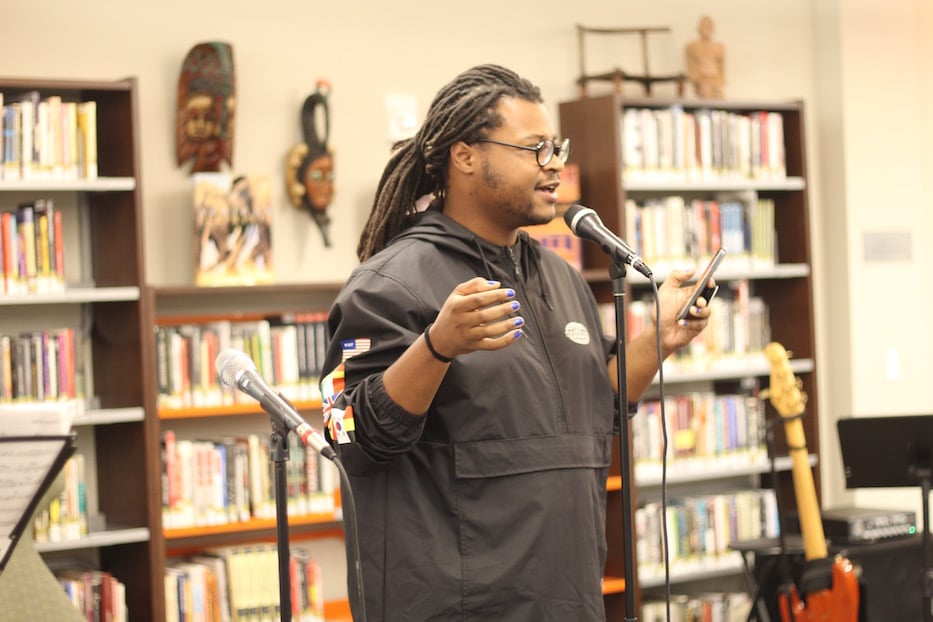
Schloss: “A lot of people didn’t want to give him his props."
That hubris would be his undoing, Schloss said. In the mid-1930s, someone stabbed Morton outside of a bar where he was playing. It curtailed his ability to play in public, and ultimately led to his death—although not before he gave an eight-hour interview that is now archived in the Library of Congress.
“A lot of people didn’t want to give him his props,” Schloss said. “I actually think it’s like, going back into the story, I think it’s very powerful that through history, and especially through these recordings, we can sort of revisit this.”
From the moment musicians took the stage, those centuries of music sprang to life, and became something that belonged both to the past and fully to the present. Pointing to Morton as a kind of kindred spirit—although he keeps it much more humble, he said with a broad smile—Davis dipped right into history. He traveled to the turn of the century with Scott Joplin and Morton, than sprang slowly forward with Ann Ronell, Harold Arlen and Ted Koehler, David Sandborn, and Miles Davis, all the way up to old-school Maysa, Vivian Green, Adele, and a transcendent take on Cyndi Lauper.
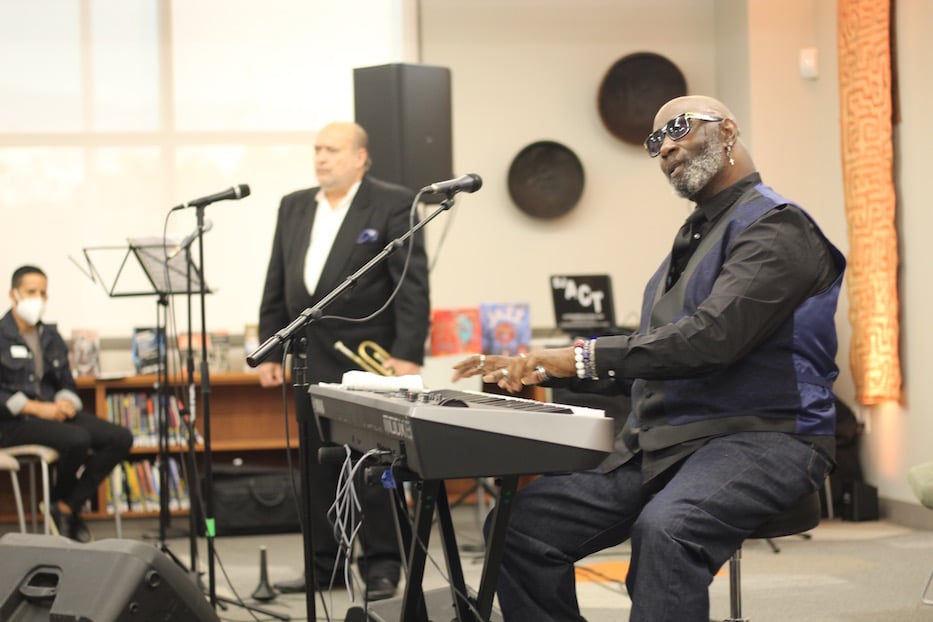
Zinno and Davis.
For Davis, that meant going back before going forward. While Morton was born in the last 15 years of the nineteenth century, Davis time-traveled back to 1868, when Joplin entered the world and transformed music as the so-called “King of Ragtime.” He pulled out Joplin’s 1902 “The Entertainer,” ready to introduce and play the piece entirely based on memory. As the first notes rang out, slow and spare, they floated over his shoulders and into the audience.
He sat straight up at the keys, and closed his eyes. Beside him, Livingston rested his bass on his lap, and massaged the air with his right hand. Davis gave a little smile; he had something up his sleeve. Within seconds, the notes were languid, melty. Then, just as quickly, they were so crisp the audience could nearly see their sharp edges. He paused for a moment, and even the space between notes hummed with electricity.
Pettaway, who had been waiting for an entrance, jumped in on percussion. Within moments, Livingngston’s bass was singing along in its low, undulating voice. Davis cracked something in the composition, riffing on the original rag as he added in notes, sped through sections, and then slowed down to add a flourish here, a cascade of keys there. By the time he finished, a few members of the audience were tapping their feet to keep time.
“I like to take compositions, and then kind of flip them, and make them my own,” Davis said. “So it may not have to sound like what Jelly Roll did.”
He was not the only one to make them his own. When Zinno joined the group for Morton’s “Kansas City Stomp,” the trumpet sang and growled over Davis’ bouncing piano. It dipped toward the deepest depths of something, and Davis responded with trilling keys that soared skyward. As Pettaway and Livingston joined in, the instruments began to call back and forth to each other, ceding the floor to Davis as keys crested right into a solo.
Every performance felt that alive, prying the capital H from history for something much more fluid. When Tallman swept onto the stage with “Stormy Weather” she did not try to mimic or mirror versions by the late Ethel Waters, Lena Horne or Etta James, but transformed it into a smoldering, soulful musical homecoming of her own (listen to it here). She hung onto the lyrics Oh, oh, keeps raining all of the time!, turning them into a refrain that felt infinite.
By the end, the word “time” alone buzzed neon at the edges, hot to the touch. As audience members soaked in her presence, she added that it marked her first time singing in public in three months, time she has taken to heal from a double knee replacement.
“I’m here,” she said, her voice full as it rose through the space, and soaked every rafter in sound. “I went through a lot but I’m here.”
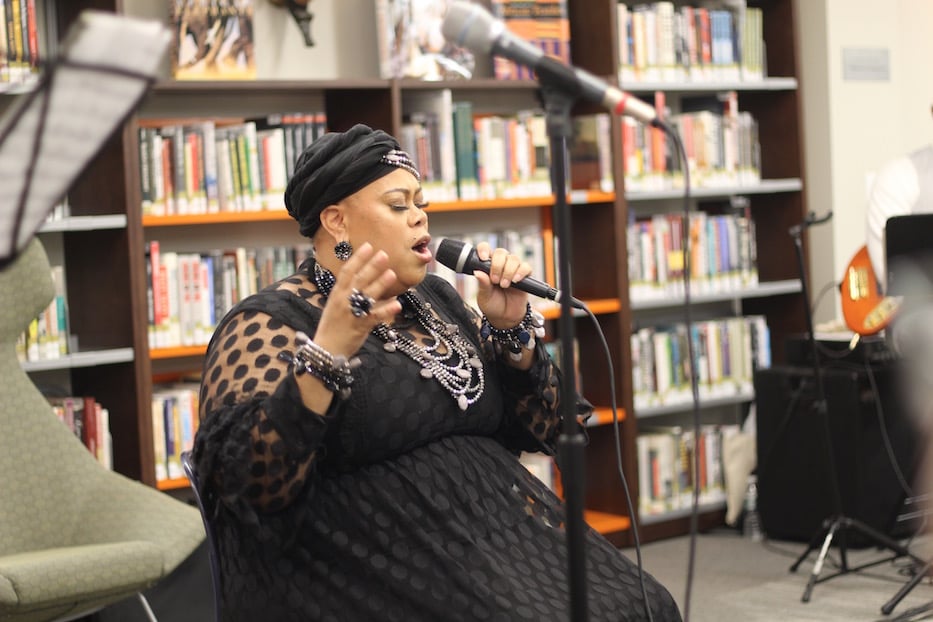 Dawn Tallman.
Dawn Tallman.
In between numbers, Davis made space for both hard-fought healing and the sheer joy of sharing space. A masterful storyteller, he wove his own trajectory alongside Morton’s, pausing for a few lines that had the whole room laughing (“Jelly Roll wore diamonds on his socks, I have no socks on” he said to instantaneous giggles). Before Zinno came onstage for the first time, Davis took the audience back to 1984, when he was fresh out of the military and working as a janitor in Zinno’s family shop in Waterbury. While they owned a music store, Davis never dared touch the piano. Tuesday marked the first time they had played together.
After over two years of pandemic workarounds—including outdoor and virtual concerts—every number was a chance to remember what it felt and sounded like to gather. When Myasa joined musicians for “Willow Weep for Me,” she eased into the song, nodding as Davis and Zinno jumped into a back-and-forth that knitted a carpet of sound beneath her feet.
When she entered, Davis took a beat and then jumped back in. She took a breath, and let the song tiptoe between decades as she dressed it up, turning it into a jazz jam. A long, drawn out cry of “Heyyyy!” rose from somewhere in the first three rows. At the mic, a smile teased at the right edge of her mouth, like a promise that she was just getting started. Beside her, Zinno loosed three sharp, brassy squeals of delight from his horn.
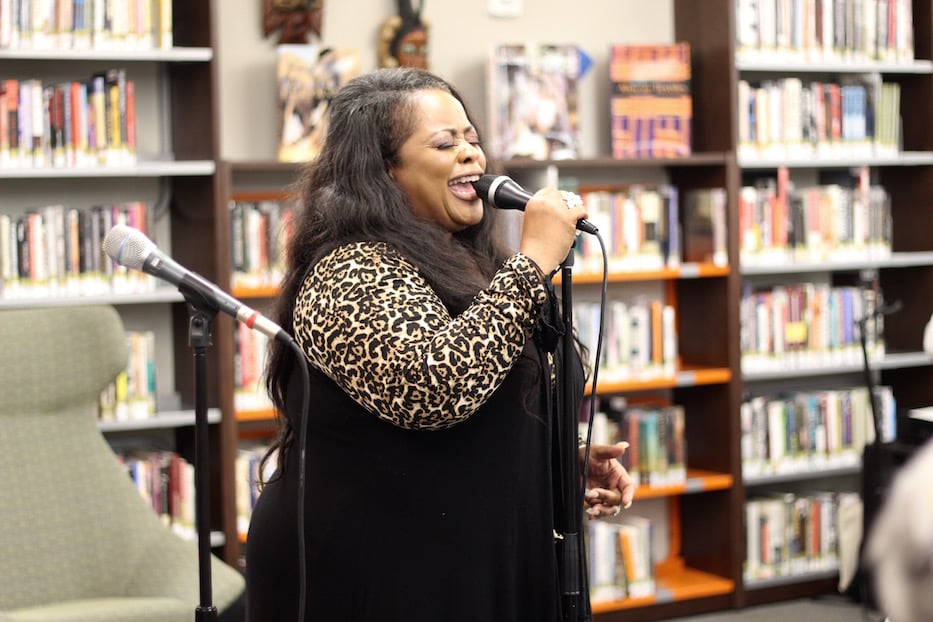
Myasa."I feel like I'm at an HBCU or something," she said, looking around at the library.
As it filled with sound, Stetson stood at the crossroads of two eras, one bygone and the other wholly contemporary. The library stands in the center of what was in the last century an indispensable part of Connecticut’s jazz corridor and a bustling, self-sufficient Black business district. Years later, those memories still hum and flit down Dixwell Avenue, where the 238 bus rumbles by like percussion, and music seeps from car windows onto the surrounding streets.
There are still reminders of that history—and its legacy—everywhere. The shell of the old Monterey is just a two-minute walk down the block, eerily quiet after decades of sweet, full sound that lasted into the wee hours of the morning. ConnCAT sits just 15 minutes away on Winchester Avenue. The space, which turned 10 earlier this year, often hums with three generations of jazz musicians and storied summer jazz brunches as it grows its footprint in the community.
The sense that jazz will endure through it all—that its survival rests on the willingness to experiment—shone in the second half of the performance. From “Bye Bye Blackbird,” musicians eased into a jam from Livingston that filled the library with sound, the bass pressing on the ceiling, the second-floor windows and the library’s doors. As Livingston and Davis stood, playing shoulder to shoulder, the sound brought some members of the audience right to their feet.
They found their feet again when Tallman returned to the stage with her song “For Me,” which preaches a message of personal happiness. Noting that “we do not have to stay in a dark place” even as the world turns on its head, she pulled the audience into her own joy, keys flying underneath her. By the time a backing track ended, she had the audience singing along. As they did, she laid down a soulful, stirring version of “If You're Happy and You Know It,” tying a through line from gospel and jazz to even nursery rhymes.
She brought that same energy to Cyndi Lauper’s “True Colors”—long a favorite of hers—before leaving the stage. As slow, soft percussion set the tone, Tallman slowed down the song, letting her voice wind around each word before starting to climb. At her left, Davis started to cry as she entered the final stretch of the song.
Audience members began talking back to her, with a language of “Ahhh!” and “Oh!” and delighted shouts of “Yes!” that came from all sides of the room. Stetson no longer felt like a library but a church, bathed in the velvet blue of night outside.
“You’re beautiful! You’re beautiful!” Tallman belted, taking the audience to church as she pointed directly to the front rows, and got glowing smiles in return. “You-uu-uu matter! You matter!”
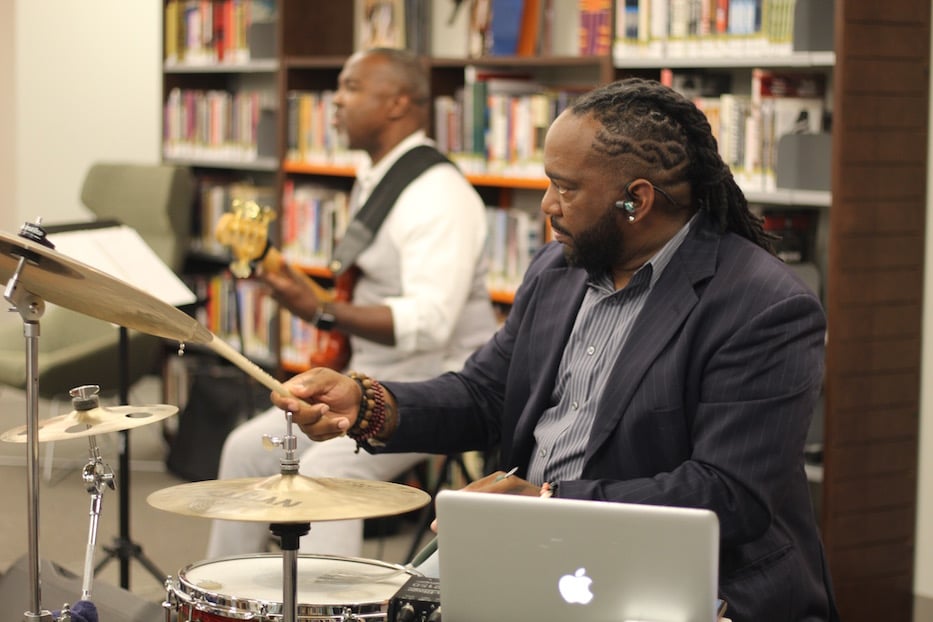
That kind of hallowed ground remained beneath Maysa, who closed the night out with a cover of Pat Benatar’s “Love Is A Battlefield” and a marathon through her “Deep Waters” that became a tribute to Black music and musicians of the twentieth and twenty-first centuries.
After starting with the silky-smooth piece—the last song she recorded with a studio before becoming her own producer—she folded in Whitney Houston, Donna Summer, Vivian Green, Natalie Cole, Adele, Muni Long, = Chaka Khan (“I got something for the old folks,” she said with a laugh as she pulled songs from the air to the mic), and Prince.
When she segued back to “Deep Waters,” members of the audience cheered. In every moment, listeners could hear the imprint of where they had started—ragtime and jazz—on the disco, soul, R&B, new wave, and pop that build their album collections at home. Stetson's second floor had become a concert venue, hands-on classroom, dance floor, and very much the kind of stage Long Wharf is dreaming of as it charts the path to itinerancy.
“Be on the lookout for Long Wharf in the community,” said Brown, who sits on the board. “Long Wharf Theatre is no longer going to have a physical home, they’re going to be coming to a neighborhood near you to bring events like these. So I hope the enthusiasm that we have here today, I hope that continues as Long Wharf Theatre continues to grow.”
Watch a full livestream of Tuesday’s concert here. A concert reading of Jelly’s Last Jam takes place Sept. 17 and 18 at Long Wharf’s 222 Sargent Dr. space. Tickets and more information are available here.

